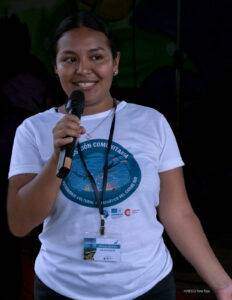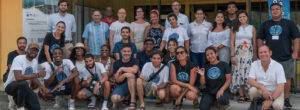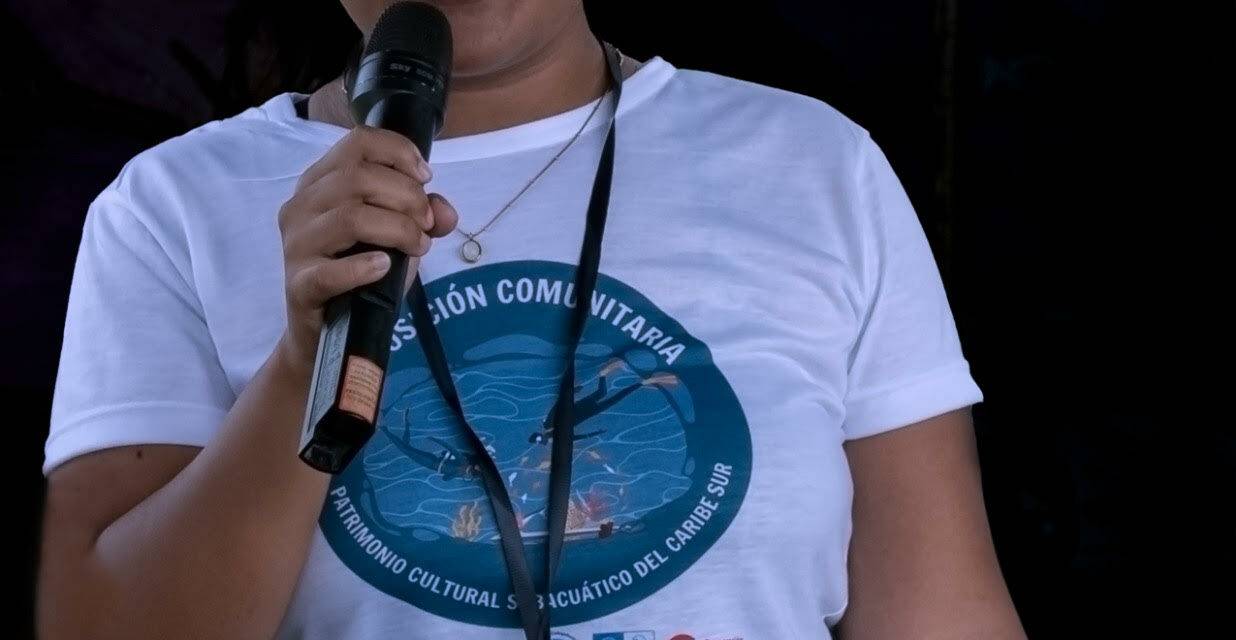 UNESCO San José works with her and a group of young people from the Caribbean of Costa Rica in the protection of the Underwater Cultural Heritage
UNESCO San José works with her and a group of young people from the Caribbean of Costa Rica in the protection of the Underwater Cultural Heritage
By Mariana Álvarez, February 14, 2023
Whoever visits the South Caribbean will find a cradle of culture, gastronomy and a smile that illuminates the entire space. That smile is that of Maraya Jiménez.
It was the year 2000, when the small town of Cocles in Limón, and the four walls of her house, saw her born. Thanks to her mother, who migrated to Costa Rica, a rich Nicaraguan heritage runs through his veins. On her father’s side, a strong lineage of workers in the banana plantations of the Atlantic zone of the country emerges.
By chance, her father and mother found themselves in this beautiful town, where the sea and the humid breeze are part of its attractions, since each of their families bought land to settle in the region. Her father, thanks to the proximity to the ocean, began to dedicate himself to fishing and diving.
The South Caribbean has always been her home, her school and her college. In that zone, she began to take her first steps as a leading woman. “In 2016 I participated in an oratory contest. Aha, that’s how it all starts,” he enthused.
For her, her everything is her connection with the people of the Community Diving Center, Ambassadors and Ambassadors of the Sea. A speech contest brought her closer to this group who are guardians of the marine world. Its impact, thanks to the work with UNESCO San José, has gone from being local to influencing at a regional level in the conservation of underwater resources.
“It was the first time that this contest was brought to the area because at least in my school we had never heard of that type of student participation and we had never had this experience in the community. The theme of the oratory contest was in the line of people of African descent. That’s when I became aware of Afro history and everything that has happened on the subject of slavery. Neither at school nor anywhere had I heard about this.”
“I had a Social Studies teacher who was a “walking book”. I questioned her and said: -why don’t they teach us this?- So, she began to tell me a little about the story. It was like opening a door.” With her oral story about people of African descent, Maraya won the competition at the national level.
Due to her achievements and involvement with the culture of the place, journalist María Suárez Toro, who is the co-founder of the Diving Center, invited her to be part of the organization. “I had always had that connection with the sea, so I got involved in the project”, says Maraya.

The organization is comprised of youth from the area who seek to leave a mark on the community and the environment. The people who are part of it train in the areas of scuba diving, underwater archeology and restoration of the seabed, thanks to the support of the United Nations.
The Center has partnered with UNESCO and other organizations such as UNFPA and UNOPS with the purpose of positioning youth as heirs of the cultural and natural legacy. Beginning her journey with the organization, she was invited to the East Carolina University in North Carolina, USA. “I learned about their projects and the maritime program of the University,” he says enthusiastically.
In that year he finished the College and became more and more involved with the Center. Her love for water she wishes to combine with her love for justice. “I started to study law at the University of Costa Rica and went to its Guanacaste campus (more than 400 kilometers from her home).
I went to live there and spent two years studying face-to-face. So, I was always there, supporting the Center from afar”. Due to the Pandemic, she returns to her beloved Caribbean to continue her studies virtually and stayed there thanks to the fact that the University has allowed her to take her studies online. This has also allowed her to dedicate more of her time to the Diving Center.
“When I returned, I became part of the Board of Directors as Secretary of the Centro. From there, we have been working more for the protection of heritage and community management”.
Maraya became interested in caring for culture and discovering her roots. “It impresses me how this ship thing could totally change the history of Costa Rica.” The origin of the ships, of which Maraya is talking about, is still not confirmed. There are clues that indicate that, presumably, they are two slave ships that are found deep in the Cahuita National Park that would date back more than 300 years. Ongoing research indicates that they could be ships of Danish origin that transported enslaved people from Africa.
The youth of the Diving Center coordinate the search to find the identity of these ships. UNESCO San José has worked with the South Caribbean community to ensure the protection and enhancement of these submerged archaeological sites, under the provisions of the 2001 Convention on the Protection of the Underwater Cultural Heritage. In 2022, together with local youth, UNESCO San José coordinated the exhibition “Caribbean South: cradle of a community underwater archeology in Costa Rica”.
Hand in hand with UNESCO, the youth worked to value underwater archaeological assets and protect this heritage. The realization of this exhibition involved institutions such as the National Museum of Costa Rica (MNCR), the Association for Integral Development (ADI) of Cahuita, the University of Costa Rica (UCR sede Caribe), The UN Population Fund (UNFPA) the Embassy of Spain in San José and the Educational Coordination and Center of the Central American Integration System (CECC/SICA).
The participation of these partners made it possible to strengthen alliances and position underwater cultural heritage as an element to achieve sustainable development within the framework of the 2030 Agenda. The Underwater Cultural Heritage reveals the historical link between the sea (and other bodies of water) and the development of human societies.
Since ancient times, the sea has been key to food, communication and trade. For this reason, the sea has been indispensable for the development of cultures, and its study and conservation is of interest to UNESCO.
The community of Cahuita is pioneer at the national level in carrying out citizen science activities to sensitize the public about the importance of this heritage and the multiple threats it faces, including climate change, looting and commercial exploitation.
UNESCO San José has facilitated intergenerational dialogue in the community, conversations with heritage protection organizations and the sharing of knowledge with experts in the field in order to promote its protection. Due to the involvement of Maraya and her organization in the protection of this Underwater Cultural Heritage, she was invited to Montevideo, Uruguay, to a meeting organized by UNESCO in with specialists in underwater archeology and technical managers of cultural heritage from 22 countries in Latin America and the Caribbean.
This meeting reinforced UNESCO’s commitment to the protection of the Underwater Cultural Heritage and strengthened the network of specialists in heritage protection. “It seems incredible to me to be able to be part of that and also be in some way the guardian of my rights, my identity, and the identity of future generations” exclaimed Maraya excitedly. “How nice that people (like me) can participate, and not only get involved, but that this connection between the communities and their historical legacy can also be created” she added.
Despite enjoying her days scuba diving, her favorite part is the connection that this project generates with the community, being able to create ties and working with people. For this reason, Maraya has worked to bring knowledge about underwater heritage and the sea to the community. “We visit schools and sing with them. We love that they tell how they imagine what is under the sea and that they imagine their own theories of how the ships could have arrived. It’s too incredible.”
When he finishes law studies, she wants to dedicate her knowledge to conservation in the Diving Center. In addition, at 22 years old, she is clear that she wants to leave a legacy in society: to be an empathetic voice that resonates with people.
Note by the author: Dedicated to Maraya’s mother: who wherever she is, is proud of her leading daughter.


